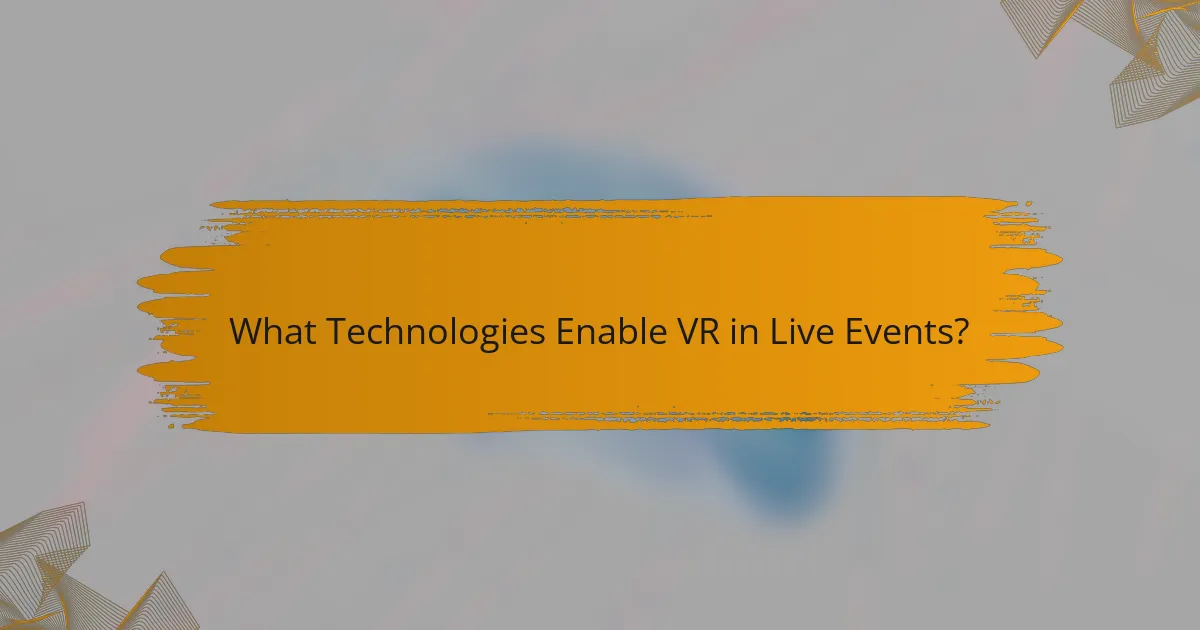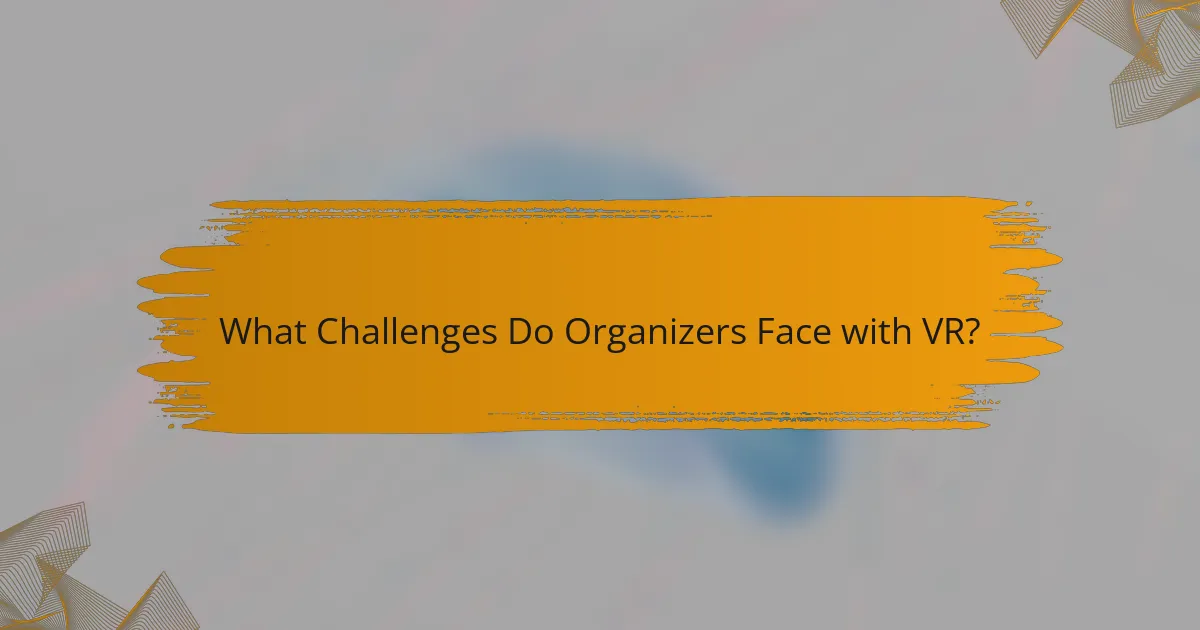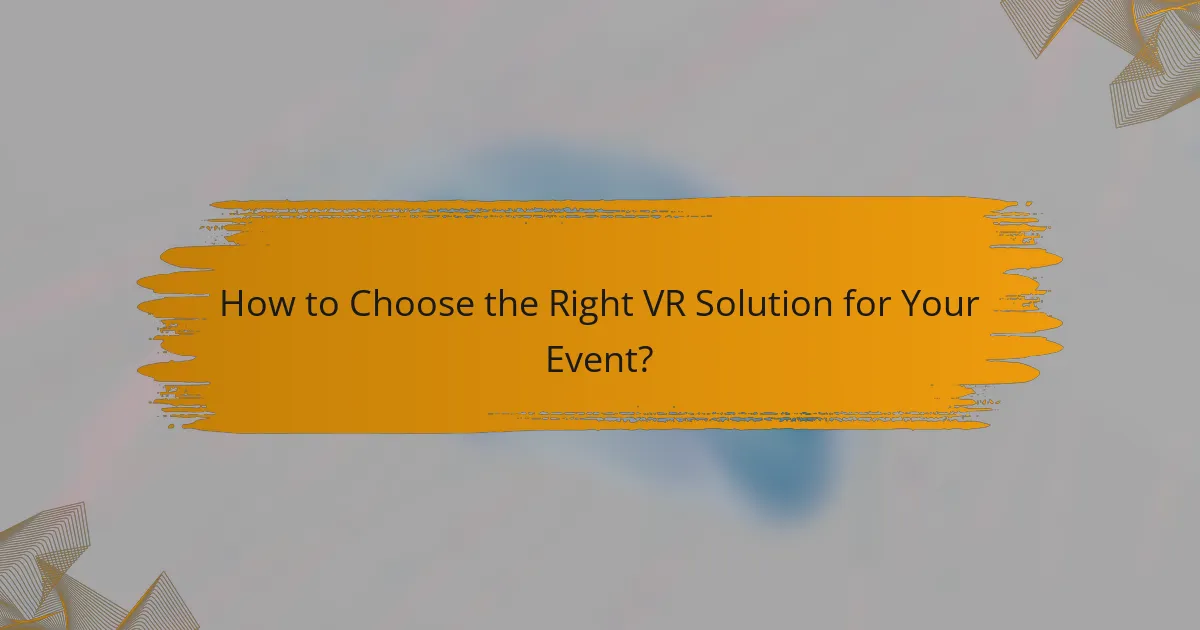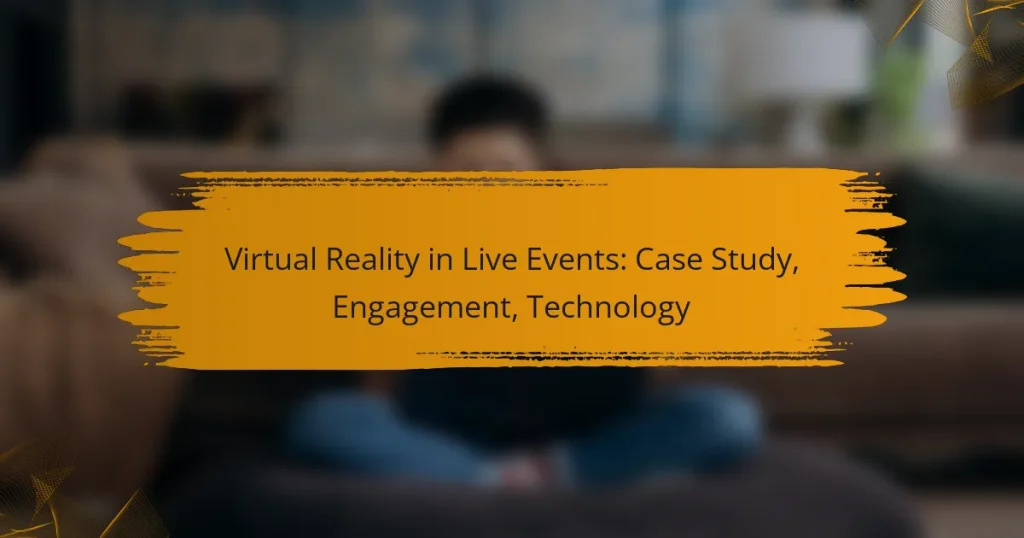Virtual reality (VR) is revolutionizing live events by offering immersive experiences that significantly boost audience engagement and participation. By merging physical and digital realms, this technology allows attendees to interact with events in unprecedented ways, enhancing their overall experience. With a blend of advanced hardware and software, VR creates dynamic environments that not only broaden audience reach but also foster innovative networking opportunities.

How Is Virtual Reality Transforming Live Events?
Virtual reality (VR) is significantly changing live events by creating immersive environments that enhance audience participation and engagement. This technology allows attendees to experience events in ways that were previously impossible, bridging the gap between physical and digital experiences.
Enhanced Audience Engagement
VR enhances audience engagement by allowing participants to interact with the event in real-time. Attendees can explore virtual spaces, participate in live polls, and engage with other viewers, creating a more dynamic atmosphere. This interactivity can lead to higher satisfaction and retention rates among participants.
Utilizing VR for audience engagement can involve gamification elements, where attendees earn rewards for participation. This approach not only keeps the audience interested but also encourages them to share their experiences on social media, further amplifying the event’s reach.
Immersive Experiences
Immersive experiences in VR transport attendees to lifelike environments, enhancing their emotional connection to the event. For instance, a concert can be experienced from the front row or backstage, providing unique perspectives that traditional formats cannot offer. This level of immersion can significantly elevate the overall experience.
Event organizers can leverage VR to create themed environments that align with the event’s purpose. For example, a tech conference might simulate futuristic settings to showcase innovations, making the experience memorable and engaging for participants.
Remote Participation
VR technology enables remote participation, allowing individuals from various locations to join live events without the need for travel. This accessibility broadens the audience base and can lead to increased attendance numbers, as people can participate from the comfort of their homes.
To facilitate remote participation, event planners should ensure that the VR platform is user-friendly and compatible with various devices. Offering technical support and clear instructions can help attendees navigate the virtual environment smoothly.
Brand Activation
Brands can utilize VR for activation by creating immersive experiences that resonate with their target audience. This approach allows companies to showcase products in a captivating way, making it easier for consumers to connect with the brand’s message.
For effective brand activation, consider integrating interactive elements that encourage audience participation. For instance, a fashion brand might allow users to try on virtual outfits, enhancing engagement and driving sales through direct links to purchase.
Case Studies of Success
Several organizations have successfully implemented VR in live events, showcasing its potential. For example, a major music festival used VR to provide virtual front-row experiences, resulting in increased ticket sales and positive feedback from attendees.
Another case involved a tech company that hosted a virtual launch event, allowing global participation. The event featured interactive demos and Q&A sessions, leading to a significant boost in product awareness and customer interest.

What Technologies Enable VR in Live Events?
Virtual reality (VR) in live events relies on a combination of hardware and software technologies that create immersive experiences for participants. Key components include VR headsets, specialized software platforms, streaming technologies, and interactive features that enhance audience engagement.
VR Headsets and Equipment
VR headsets are essential for delivering immersive experiences in live events. Popular options include the Oculus Quest, HTC Vive, and PlayStation VR, each offering varying degrees of resolution, field of view, and comfort. When selecting headsets, consider factors like user experience, compatibility with other equipment, and budget, which can range from a few hundred to several thousand dollars.
In addition to headsets, other equipment such as motion controllers and haptic feedback devices can significantly enhance the VR experience. These tools allow users to interact more naturally within the virtual environment, making events more engaging and memorable.
Software Platforms
Software platforms play a crucial role in creating and managing VR content for live events. Platforms like AltspaceVR, VRChat, and Engage provide environments where users can interact, socialize, and participate in events. Each platform has its own set of features, so it’s important to choose one that aligns with the event’s goals and audience preferences.
When selecting a software platform, consider ease of use, customization options, and community support. Some platforms may require additional development resources, while others offer ready-to-use templates that can save time and effort.
Streaming Technologies
Streaming technologies are vital for delivering VR content to remote audiences. Solutions like WebRTC and RTMP enable real-time video streaming, allowing participants to join live events from anywhere. It’s essential to ensure a stable internet connection, as latency can affect the overall experience.
When planning a VR event, consider the bandwidth requirements for streaming high-quality video and audio. A minimum of 10 Mbps is typically recommended for smooth performance, but higher speeds may be necessary for larger audiences or more complex content.
Interactive Features
Interactive features enhance audience engagement during VR live events. Options include live polls, Q&A sessions, and virtual networking opportunities, allowing participants to interact with speakers and each other. These features can significantly increase audience satisfaction and retention.
To maximize interactivity, consider integrating gamification elements, such as rewards for participation or challenges that encourage collaboration. This approach can create a more dynamic environment and foster a sense of community among participants.

What Are the Benefits of Using VR in Live Events?
Using virtual reality (VR) in live events offers significant advantages, including enhanced engagement, broader audience reach, and innovative networking opportunities. These benefits can transform the way attendees experience events, making them more interactive and accessible.
Increased Reach and Accessibility
VR technology allows event organizers to reach a global audience without geographical limitations. Attendees can participate from anywhere in the world, making events accessible to those who might not be able to travel due to cost or other constraints.
This increased accessibility can lead to higher attendance rates, as people can join from their homes or offices. For example, a conference that traditionally attracts a few hundred attendees can potentially engage thousands through a VR platform.
Cost-Effectiveness
Implementing VR in live events can reduce costs associated with venue rental, travel, and accommodations. By hosting virtual events, organizers can save on expenses while still providing a rich experience for participants.
Additionally, VR can minimize the need for physical materials, such as printed brochures or promotional items, further lowering costs. This makes it a financially viable option for both large corporations and smaller organizations.
Data Collection and Analytics
VR platforms offer robust data collection capabilities, allowing organizers to gather insights on attendee behavior and preferences. This data can be invaluable for improving future events and tailoring content to audience interests.
For instance, analytics can reveal which sessions were most popular or how long attendees engaged with specific content. This information helps in making informed decisions about programming and marketing strategies.
Enhanced Networking Opportunities
VR creates unique networking opportunities that traditional events may lack. Attendees can interact in virtual spaces, engage in discussions, and exchange contact information in real-time, regardless of their physical location.
Platforms often include features like virtual lounges or breakout rooms, facilitating organic conversations and connections. This can lead to meaningful collaborations and partnerships that extend beyond the event itself.

What Challenges Do Organizers Face with VR?
Organizers face several challenges when integrating virtual reality (VR) into live events, including technical limitations, user adoption barriers, and content creation costs. These factors can significantly impact the effectiveness and reach of VR experiences at events.
Technical Limitations
Technical limitations in VR can hinder the overall experience for users. Issues such as latency, hardware compatibility, and bandwidth requirements must be addressed to ensure smooth interactions. For instance, a VR experience may require high-speed internet connections, which may not be available in all venues.
Additionally, the need for specialized equipment can pose a challenge. Not all attendees may have access to VR headsets or the necessary devices, limiting participation. Organizers should consider providing equipment or ensuring compatibility with widely-used devices to enhance accessibility.
User Adoption Barriers
User adoption barriers can significantly affect the success of VR in live events. Many potential users may feel intimidated by new technology or may not understand how to use VR effectively. This reluctance can lead to lower engagement levels during the event.
To overcome these barriers, organizers should offer clear instructions and demonstrations on how to use VR systems. Creating a welcoming environment and providing support staff can also help ease users into the experience, increasing overall participation and enjoyment.
Content Creation Costs
Creating high-quality VR content can be expensive and time-consuming. Costs can vary widely depending on the complexity of the experience, with budgets ranging from a few thousand to tens of thousands of dollars. This investment can be a significant barrier for smaller organizations or those with limited resources.
Organizers should evaluate the potential return on investment when considering VR content. Collaborating with experienced developers or utilizing existing platforms can help reduce costs while still delivering engaging experiences. Additionally, prioritizing content that aligns closely with event goals can maximize the impact of the investment.

How to Choose the Right VR Solution for Your Event?
Choosing the right VR solution for your event involves understanding your audience’s preferences, the technology available, and your budget. A well-selected VR platform can enhance engagement and provide a memorable experience, while a poor choice may lead to technical issues or dissatisfaction.
Assessing Audience Needs
Understanding your audience’s needs is crucial when selecting a VR solution. Consider factors such as age, tech-savviness, and interests. For instance, younger audiences may prefer immersive experiences, while older attendees might appreciate simpler, more accessible options.
Gather feedback through surveys or focus groups to determine what features would resonate most. This could include interactive elements, social sharing capabilities, or gamification aspects. Tailoring the VR experience to your audience can significantly boost engagement and satisfaction.
Additionally, consider the accessibility of the VR solution. Ensure that it accommodates individuals with disabilities, providing options like audio descriptions or alternative navigation methods. This inclusivity not only broadens your audience but also enhances the overall experience for everyone involved.


